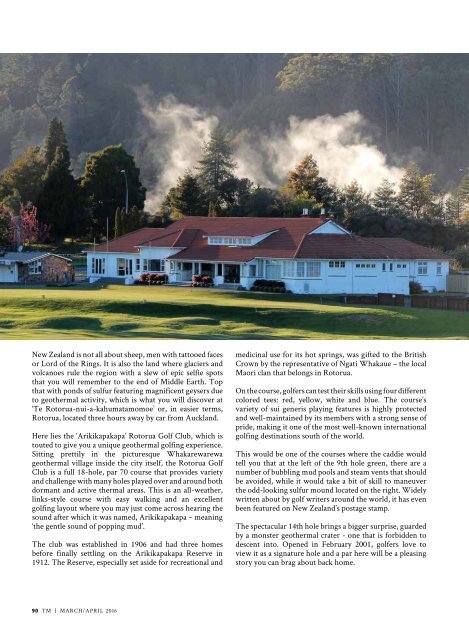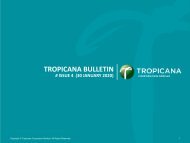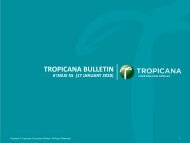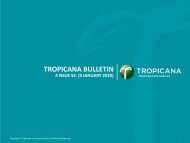Tropicana Magazine Mar-Apr 2016 #106: The Active Issue
Mr Jayden Liew on his Road to Success in this Active Issue
Mr Jayden Liew on his Road to Success in this Active Issue
Create successful ePaper yourself
Turn your PDF publications into a flip-book with our unique Google optimized e-Paper software.
New Zealand is not all about sheep, men with tattooed faces<br />
or Lord of the Rings. It is also the land where glaciers and<br />
volcanoes rule the region with a slew of epic selfie spots<br />
that you will remember to the end of Middle Earth. Top<br />
that with ponds of sulfur featuring magnificent geysers due<br />
to geothermal activity, which is what you will discover at<br />
‘Te Rotorua-nui-a-kahumatamomoe’ or, in easier terms,<br />
Rotorua, located three hours away by car from Auckland.<br />
Here lies the ‘Arikikapakapa’ Rotorua Golf Club, which is<br />
touted to give you a unique geothermal golfing experience.<br />
Sitting prettily in the picturesque Whakarewarewa<br />
geothermal village inside the city itself, the Rotorua Golf<br />
Club is a full 18-hole, par 70 course that provides variety<br />
and challenge with many holes played over and around both<br />
dormant and active thermal areas. This is an all-weather,<br />
links-style course with easy walking and an excellent<br />
golfing layout where you may just come across hearing the<br />
sound after which it was named, Arikikapakapa – meaning<br />
‘the gentle sound of popping mud’.<br />
<strong>The</strong> club was established in 1906 and had three homes<br />
before finally settling on the Arikikapakapa Reserve in<br />
1912. <strong>The</strong> Reserve, especially set aside for recreational and<br />
medicinal use for its hot springs, was gifted to the British<br />
Crown by the representative of Ngati Whakaue – the local<br />
Maori clan that belongs in Rotorua.<br />
On the course, golfers can test their skills using four different<br />
colored tees: red, yellow, white and blue. <strong>The</strong> course’s<br />
variety of sui generis playing features is highly protected<br />
and well-maintained by its members with a strong sense of<br />
pride, making it one of the most well-known international<br />
golfing destinations south of the world.<br />
This would be one of the courses where the caddie would<br />
tell you that at the left of the 9th hole green, there are a<br />
number of bubbling mud pools and steam vents that should<br />
be avoided, while it would take a bit of skill to maneuver<br />
the odd-looking sulfur mound located on the right. Widely<br />
written about by golf writers around the world, it has even<br />
been featured on New Zealand’s postage stamp.<br />
<strong>The</strong> spectacular 14th hole brings a bigger surprise, guarded<br />
by a monster geothermal crater - one that is forbidden to<br />
descent into. Opened in February 2001, golfers love to<br />
view it as a signature hole and a par here will be a pleasing<br />
story you can brag about back home.<br />
90 TM | MARCH/APRIL <strong>2016</strong>


















